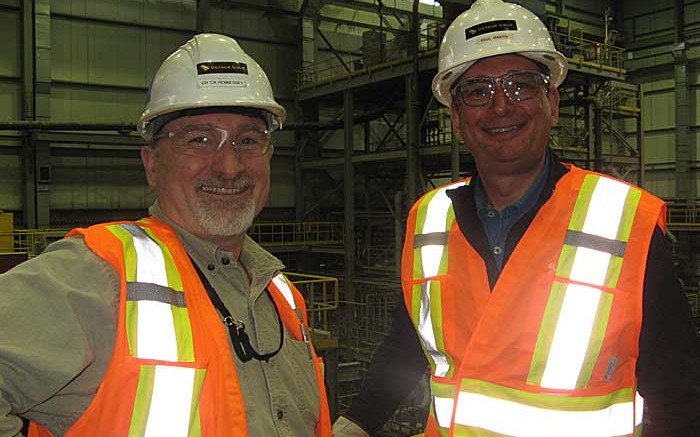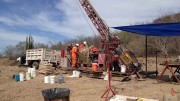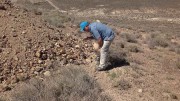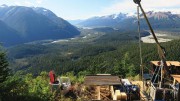COCHRANE, ONTARIO — When you look at the careers of Detour Gold’s (TSX: DGC) chief operating officer Pierre Beaudoin and president and CEO Paul Martin, it’s almost as if both men had been groomed for their task of bringing the company’s massive open-pit gold mine in northeastern Ontario to design capacity in under two years, all while hacking away at the company’s debt.
Before joining Detour Gold in February 2010, Beaudoin spent 16 years at Barrick Gold (TSX: ABX; NYSE: ABX) improving plant productivity at the gold major’s operations around the globe. His work ranged from the commissioning of the Tambo gold processing plant in Chile to directing prefeasibility and feasibility studies of the Cerro Casale open pit copper–gold
project in Chile, delivering a feasibility study for the Donlin Creek open-pit project in Alaska and commissioning the Buzwagi gold mine in Tanzania. He also held senior management positions at the Doyon processing plant in Quebec, the Holt-McDermott plant in Ontario and the Kargoorlie Super Pit in Australia.
Martin joined Detour as chief financial officer in September 2008 after previously holding the CFO spot at New Gold (TSX: NGD; NYSE: NGD) and Gabriel Resources (TSX: GBU). His background as a chartered accountant and his ability to negotiate project finance facilities made him a natural fit in the mining world. Between 2010 and 2011 under Martin’s stewardship as CFO, Detour raised about $2 billion in debt and equity to pay for construction, and he stepped into the top job as interim CEO after the sudden resignation of Gerald Panneton in November 2013. Less than three months later Martin was promoted permanently to the corner office.
“I think I’ve been working my whole career in the industry to get ready for this position,” Martin says following a recent tour of the world-class Detour Lake mine attended by thirty analysts and investors on June 4. “I have the benefit of five years here and from a stability standpoint — internally and externally — to have an insider take on the position has some natural benefits to bringing in an external person.”
One of those benefits is an intimate knowledge of the balance sheet and how best to manage debt payments over the next 24 months to take Detour’s US$110 million finance lease from Caterpillar (NYSE: CAT) down to a more palatable level and a US$30 million revolving credit facility from a syndicate of five banks down to zero. Factor in US$500 million in convertible notes that come due in November 2017 and the company’s total debt stretches to US$640 million.
“This company in the current gold environment has too much debt — that’s an obvious statement,” Martin offers during a series of presentations on the 185 km bus trip from the airport in Cochrane to the mine site. “We’re starting to get into a position of strength but we’re not there yet. If there’s one thing we’ve learned it’s that this is a big mine — it’s bigger than I think a few of us gave it credit for — and therefore we need to have a financial safety net there in case we have an unexpected situation.”
While Martin is busy meeting his ambitious target this year of maintaining a cash balance on the books of US$100 million and pruning up to US$80 million in debt, Beaudoin has his hands full completing the ramp up and dealing with some of the challenges that have dogged the operation since it entered commercial production ahead of schedule on Aug. 12, 2013. These included falling behind the mine schedule, which resulted in lower mined grade, higher mining dilution (when waste material gets intermingled with ore) in the first few quarters, accessing higher grade ore in the pit only at year-end, and poor availability in the mill. In 2013 Detour made three separate downward revisions to its production guidance.
Martin says the company expects to be cash flow positive within the second half of the year provided the mill ramp up continues to improve and the gold price cooperates. Detour took a little of the pressure off in March with a $173 million equity financing, bringing cash and short-term investments at the end of the first quarter to US$145.2 million. The company also has a safety net in the form of a US$45 million undrawn credit facility with a bank syndicate (BMO, CIBC, CBA, RBC and TD) that is secured by the Detour Lake property.
Detour is also making headway on debt reduction. It paid down US$40 million of its credit facility in the first quarter and received a waiver from Caterpillar on its principal repayments in the first and second quarters of this year. If things work out, Martin says, and the gold price cooperates, meaning more cash in the treasury by the year-end, Detour can make those principal payments sooner than later.
Martin emphasizes that Detour has a fair amount of flexibility (it can repay the CAT lease ahead of time without penalty) and remains on solid terms with all of its lenders.
“I would say we have good relationships with our banks and we have an even better relationship with CAT finance,” he continued. “It’s a very simple equation: We’ve purchased US$300 million worth of equipment and they want to deliver the next seventeen trucks to take us up to our maximum mining fleet. So we have a really, really good working relationship with them.”
As for the US$500 million in convertible notes, Martin says management is currently discussing how best to tackle that debt. One option is to refinance up to US$300 million of the notes, which would allow the company to invest more money into the mine and continue to probe exciting exploration opportunities elsewhere on the property.
“We think US$300 million is the right number looking at normalized debt to EBITDA in the current gold price environment so don’t be surprised if we would look to refinance up to US$300 million worth of those notes,” Martin says. “We find that a very manageable position. We know in our life of mine that in 2017–2018 we’re up close to 700,000 oz. gold per year. We would have a very strong balance sheet, we could garner a very attractive facility, and we’re quite prepared to do that.”
Under a limited hedging program Detour kicked off in January, the company is permitted to hedge up to 50% of its production in 2014 and Martin says a final decision on whether to continue the program in 2015 will be made before the end of the third quarter.
So far the hedging program — overseen by chief financial officer James Mavor, previously vice-president and treasurer at Barrick from 2007–2012 — has averaged US$1,250 per oz. to US$1,260 per oz. And despite its critics, Martin says, the program has been useful during the mine’s ramp-up stage.
“Ninety-five percent of the people that we speak to are in favour of what we’ve done this year,” Martin says of the hedging program. “They understand it is protection of the ramp-up year. Let’s see where we are at the end of the year and we’ll make a further evaluation.”
Where management wants to be at the end of the year on the operations side is producing at a rate of 55,000 tonnes per day, which is beginning to look well within its grasp as the pit starts opening up, allowing more efficient use of the shovels and access to better grade areas in the south pit wall. Dilution is below budget and in-line with the life-of-mine plan and reconciliations (to the block model and between the mine and mill) are performing well. The mill continu
es to increase both availability and recoveries.
“Last year we had a challenging ramp up combined with a 30% reduction in the gold price,” Martin comments after the site visit. “Any one of those two would be significant for any corporation and added some grey hair to the management team. But they also make you stronger by weathering them and moving forward and that’s where we are now. We remember 2013 but we’re focused on 2014.”
In the first quarter, the plant averaged throughput rates of 45,282 tonnes per day (3% below plan) and due to a slower start-up following a shutdown in December 2013 (for repairs to the pre-leach thickener system and the replacement of the bottom section of the torque cage), mill availability was running at 80% (2% below plan) but reached 86% in March. Mill recoveries surpassed the 91% design rate over the last eighty days about 67% of the time.
At the mine, 19.2 million tonnes were mined in the first quarter versus the plan of 20.9 million tonnes — a shortfall of 1.7 million tonnes due to in-pit handling, advancing the south wall pushback in the open pit and tying up three shovels with the removal of overburden.
Total cash costs per oz. sold in the first quarter fell to US$976 per oz. from US$1,174 per oz. in the fourth quarter of 2013, but the number of gold ounces sold also fell to 84,560 oz. versus 95,000 oz. in the previous quarter.
The goal in the second quarter is to be mining waste and ore at a rate of 220,000 to 230,000 tonnes per day, up from 213,000 tonnes in the first quarter, and to boost the milling rate to more than 50,000 tonnes per day.
Detour expects to complete the pushback of the south wall and the south ramp in the pit this summer, therein getting better exposure to higher grade ore for mining in the second half of the year. It is also preparing to break through into the past-producing Campbell open pit, while staying focused on limiting internal and external dilution (which Detour says it can do as the pit opens up and the positioning of the shovels improve.)
The game plan at the mill—a conventional gravity, cyanidation and carbon-in-pulp facility — is to improve fragmentation, optimize secondary crushers and liner profiles, improve crusher availability and better manage stockpiles.
In the second half of the year, Detour will continue its debottlenecking exercise by improving the primary crusher conveyor, installing an additional cyanide destruction tank (which will reduce downtime risk, trim opex [by reducing residence time], increase stability and allow higher tonnage) and a second oxygen plant (which will improve recoveries and use less cyanide).
Meanwhile a stockpile continues to grow in size — reaching 2.8 million tonnes at a grade of 0.78 gram gold per tonne at the end of the first quarter — up from 1.77 million tonnes averaging 0.72 gram gold per tonne at the start of commercial production.
By the end of the mine life the company expects the low-grade stockpiled material will have swelled to about 107 million tonnes grading 0.45 gram gold per tonne for 1.5 million oz. gold, and is considering options to extract value from it. One option is heap leaching the material and the company has already started test work and expects to have results later this year. The other option is to recover just the fines.
Under an updated life-of-mine plan unveiled in February, the open-pit mine and mill supports a 21.7-year operating life based on current reserves of 15.5 million oz. of gold, or 476 million tonnes grading 1.02 grams gold per tonne. Life-of-mine production will average 660,000 ounces of gold at total cash costs of C$723 per oz. sold, but during the next five years annual gold production will average 600,000 oz. at total cash costs of C$759 per oz. sold.
Many analysts and investors on the tour liked what they saw. “In a sign of confidence from the plant’s operational team they are now focused more on moving the ‘little dials’ instead of still needing to move the ‘large dials,’” Bradley Shisler of Dallas-based Condire Investors told The Northern Miner after the site visit, his second tour of the mine in just over a year. “Overall, the progress has been strong throughout the operations.”
Brian Quast of BMO Capital Markets pointed out in a research note that as a bulk tonnage operation and therefore reliant on large equipment operating at maximum efficiency for profitability, “the ability to be very precise in taking buckets of ore versus buckets of waste on a day-to-day basis should not be underestimated in the long term health of the operation,” and said Detour in his opinion “seems to be heading in the right direction with this.”
Michael Siperco of Macquarie Research increased his target price on Detour from $16 per share to $18 per share following the visit and confirmed that the company remains a top pick this year “on further evidence that the ramp up of Detour Lake is progressing well and on our higher confidence that mill optimization will bear fruit in the near term.”
His long-term thesis is unchanged for the “premium” asset, he says, which has a long mine
life and leverage to higher gold prices.
“The positive directional results in the first quarter are even more impressive considering that this is only the second quarter of commercial production reported for a mine and mill that should be producing gold for +20 years,” Siperco penned in his research note. “Every significant indication of mill/mine performance is directionally positive and bodes well for future performance . . . we see substantial further upside in 2014 beyond the 189% year-to-date return, with further room to run given large price/net asset value discount it trades at versus peers (0.47 times versus 0.86 times).”
For now Detour is sticking to its 2014 production guidance of 450,000 oz. gold to 500,000 oz. gold at cash costs of US$800-900 per oz. (It produced 107,000 oz. gold in the first quarter compared to 232,000 oz. in all of 2013.)
Looking ahead, the company is considering removing the pebble circuit at the mill, which produces between 700 and 800 tonnes per hour of mainly barren pebbles. The pebbles don’t need to be recovered and if test work proves positive (that is, if the pebbles are confirmed barren), the circuit could be used instead to add 8,000 to 12,000 tonnes per day of additional milling capacity, which would translate into about 50,000 to 75,000 ounces of gold per year in additional production.
In a presentation over lunch, chief operating officer Beaudoin also touched on a prefeasibility study the company is working on for Block A, a deposit about 1 km northwest of the Detour Lake open pit that contains a measured and indicated resource of 2 million oz. gold at an average grade of 1.15 grams gold per tonne.
“We don’t think it’s a big challenge to bring this into reserve by the end of the year,” Beaudoin says, adding that the core of Block A is covered in the company’s environmental baselines and the assumption is that it would be brought into production at the end of the Detour Lake mine life. “For better economics, however, the key to Block A is finding a place for it in the plant earlier,” he continues.
One of the most exciting aspects of Detour’s future, however, is the new high-grade discovery south of the current open pit along a major east-west structural break less than 6 km south of the Sunday Lake deformation zone that hosts the Detour Lake mine and which Beaudoin describes as “one of the most important discoveries on the Detour Trend in fort
y years.”
Earlier this month Detour released assay results from its exploration program in the Lower Detour area with highlights from the 58N Zone including intercepts of 12.74 grams gold per tonne over 28 metres, 11.82 grams gold over 32.4 metres and 9.69 grams gold over 30.3 metres.
Drilling in Zone 75, 20 to 50 metres south of the 58N Zone, returned assays of 4.31 grams gold over 7.3 metres, 10.82 grams gold over 7.0 metres and 7.41 grms gold over 5.1 metres.
“If there was a take-away it was management’s enthusiasm over the 58N Zone,” Steve Parsons and Don De Marco of National Bank Financial wrote in a note after the tour. “While still early stage we concur with the benefits to DGC if realized.”
Beaudoin is encouraged by the results so far and says he hopes to find a lot more to potentially develop a higher grade feed source for the mine.
“Within two seasons we’ve proven that we have high-grade material close to the mine, right on our doorstep,” Beaudoin says enthusiastically. “We’re all excited about this and if we could spike grades it would be a screamer.”
Of course with the recent take-out of Osisko Mining and its large Canadian Malartic gold mine, which shares attributes with Detour Lake such as a long mine life and an excellent geopolitical jurisdiction, talk often comes down to Detour as the next takeover target once the operation is optimized.
But Martin says he doesn’t dwell on that fact.
“Our job is to execute and not worry about what external forces could bring to bear on you,” he says. “People who dwell on potential takeovers can take their eye off the ball and that’s certainly not something we are doing here.”
Having said that, he adds, the Osisko acquisition has brought attention to large, low-grade operations in safe jurisdictions, which has been an overall positive in the industry.
“I’m aware of only one mine that is producing over 500,000 oz. a year, is located in a safe jurisdiction and is not controlled by a major, which makes us a very unique situation and with the current gold price environment we won’t see a large pipeline of these types of deposits developed likely until the next gold cycle.”





What do you think, good eh